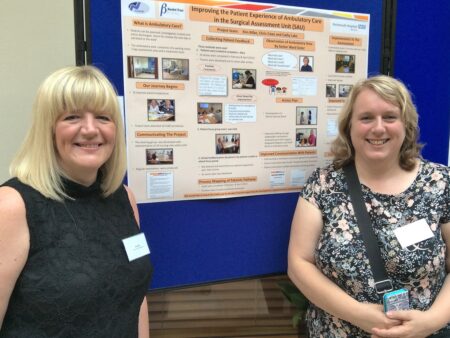Home Resources Project Reports Improving the Patient Experience of Ambulatory Care in the Surgical Assessment Unit
Improving the Patient Experience of Ambulatory Care in the Surgical Assessment Unit
| Leader(s) | Chris Caws, Cathy Lake and Kim Bilbe |
| Location | The Surgical Assessment Unit, Portsmouth Hospital Trust |
| Duration | November 2014 – October 2016 |
| Received for Publication | September 2017 |
The Surgical Assessment Unit (SAU) is located in a 28 bedded inpatient ward within a large acute hospital, Portsmouth Hospital Trust. The emergency surgery service is developing to enable more people to be assessed as ambulatory patients rather than as an inpatient. This provides efficiencies for both the patient and the service. To cater for this, a waiting room, a three-trolley space assessment bay and a single treatment room was created as an ambulatory area at the entrance to the ward. Initially the ambulatory service had low numbers of people attending but as the service has grown and developed it became clear that a more robust business plan, strategy and standard operating procedure was urgently required alongside the building work. The senior nurse leaders within the unit got together to develop a project plan to look at creating a patient centred service within the ambulatory area and to develop clear operating procedures to care for people attending for assessment.
The project team consisted of the Senior Ward Sister, Ward Sister/Nurse Practitioner and the Practice Educator as lead. A steering group consisting of a Health Care Support Worker, Band 5 Staff Nurses and Nurse Practitioners was developed and regular workshops facilitated by the project team, enabled the opportunity to discuss ideas and feedback with staff throughout the project.
Patient feedback was obtained by collecting patient diaries, verbal feedback via telephone, a patient focus group event and a review of patient complaints. Observation of the ambulatory area by the Senior Ward Sister was also completed. This feedback was reviewed and the themes identified were developed into an action plan that became the focus of the project. Data was also collected to develop a process map of the patient pathway looking at the length of time patients waited to receive analgesia, investigations, treatment and information etc. Analysing and presenting this data to the management team, supported the senior nursing team in resourcing additional ward clerk cover and designated staff to staff the ambulatory area.
Outcomes of the project included improvements to the environment of the waiting room area including signage to the unit, development of initial clinical assessment documentation and pathway specific documentation, and improved communication strategies for patients including patient information leaflets.
This project was supported by the Foundation of Nursing Studies Patients First Programme in partnership with the Burdett Trust for Nursing.
Comments are closed.


